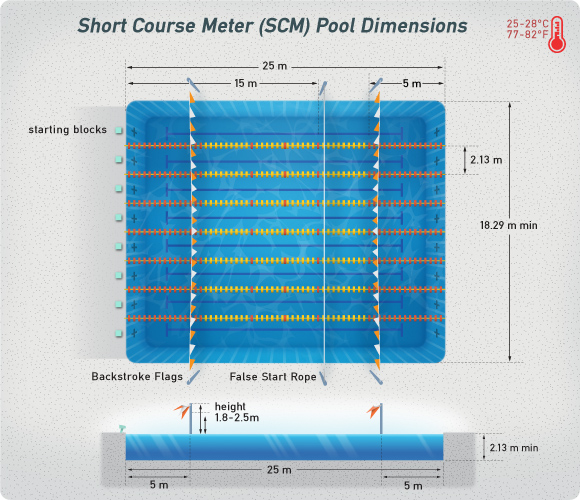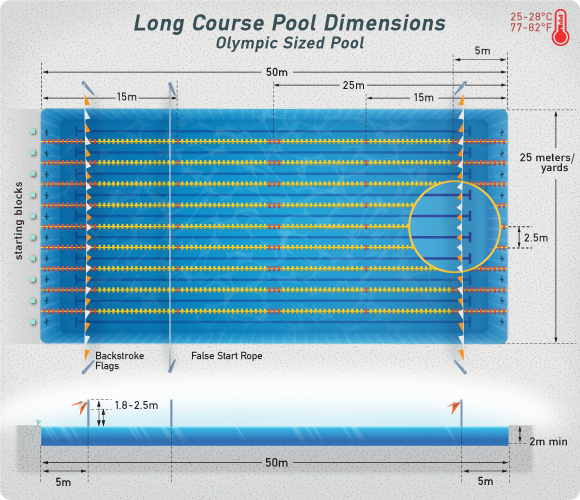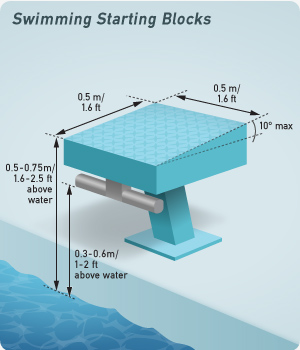Swimming Pool Dimensions
There is a good chance that if you have access to a public or campus-based pool, it's an inground pool designed for lap swimming. However, lap pools come in many different sizes and shapes, and each has its own unique pool design characteristics.
Swimming’s governing body — Fédération Internationale de Natation (FINA), which translates to "International Swimming Federation” — has a series of guidelines that describe pools acceptable for competition. It’s rare that a pool meets every one of these standards, but some important aspects should remain consistent in a good lap swimming facility.
Short Course & Long Course
There are two regulation pool sizes that exist in the world of competitive swimming. They are:
- Short course pools: Smaller pools, more common at public swimming locations or high schools.
- Long course pools: Larger pools are normally found on college campuses or higher-end swimming facilities.
Although metric and non-metric pool lengths are used in USA Swimming competitions, FINA only accepts international records swum in long-course pools.
Short Course
- Length: 25 meters or 25 yards
- Abbreviations: SCM means 25 meters long, while SCY means 25 yards long
- Number of lanes: four or more

Long Course or Olympic Distance
- Length: 50 meters (164 feet)
- Width: 25 meters (84 feet)
- Number of lanes: 8 to 10
- Lane width: 2.5 meters (8.2 feet)
- Depth: At least 2 meters (6.6 feet)
- Temperature: 25-28 degrees Celsius (77–82 degrees Fahrenheit)
Sometimes pools are designed to accommodate both dimensions, with a length of 50 meters and a width of 25 yards. In these instances, a mobile bulkhead often helps set the pool up for long course or short course.

Lane Lines & Markings
Lane lines are wire cables covered with small plastic buoys or “floats” that separate each lane. In a short course pool, the floats will change color at the 15 meter (49 foot) mark. In a long course pool, they will change color at the 25 meter (82 foot) mark. If the floats do not change color for that entire stretch, the distances may be marked by a single float of a different color. Lane lines should be 2.5 meters (8.2 feet) wide, although this varies quite a bit from pool to pool.
Lane markings are contrasting, usually tiled lines along the bottom and ends of each lane. It is common for the end of each lane to have a “+” — also known as a target line — centered on the end of each wall. The cross line on the + should be 0.5 meters (1.6 feet) long and 0.3 meters (1 foot) below the surface of the water. Similarly, a line down the middle of the lane — ending in a “T” at each wall — is often along the bottom of the pool. Each T stops 1.6 meters (5.3 feet) from the wall.
While these markings are standard for competition pools and common in others, they are not ubiquitous. Many pools that have a shallow end also have a line that marks where the depth begins to change.
Starting Blocks
 Starting blocks are used in competition. Each individual swim or leg of a relay begins with a dive from these blocks. The only exception is for backstroke races, which begin in the water with the swimmer holding on to the grips or handles included for backstroke starts.
Starting blocks are used in competition. Each individual swim or leg of a relay begins with a dive from these blocks. The only exception is for backstroke races, which begin in the water with the swimmer holding on to the grips or handles included for backstroke starts.
The height of the starting block platform should be between 0.5 meters (1.6 feet) and 0.75 meters (2.5 feet) above the surface of the water. The surface area should be at least 0.5 meters (1.6 feet) x 0.5 meters (1.6 feet) and should be covered with non-slip material. The angle of the platform should not exceed 10 degrees.
Starting blocks also usually include handles, grips, or slots for backstroke starts. These should be between 0.3 meters (1 foot) and 0.6 meters (2 feet) above the surface of the water. The handles should be parallel to the surface of the end wall and not extend past the wall.
Backstroke Flags
Nearly all pools include backstroke flags, used by swimmers to gauge how far they are from the wall. FINA requires a height between 1.8 meters (5.9 feet) and 2.5 meters (8.2 feet) above the surface of the water and 5 meters (16.4 feet) from the wall.
Not All Pools Are the Same
The type of pools that you have access to might (and probably won’t) exactly match FINA’s specifications. Because public pools cater to so many different groups — swimmers, water polo players, children’s swim lessons, lifeguard training, water aerobics — standard designs are often modified to better fit the needs of all users. While you can expect the bulk of lap swimming pools to have most of the features described in this guide, each pool will vary.
Other Resources
The dimensions discussed above are included in the design of the majority of lap swimming pools. FINA does, however, have standards for nearly every aspect of a pool and deck. This includes gutter screens, acceptable surface materials, and touchpad thickness for competitions.
